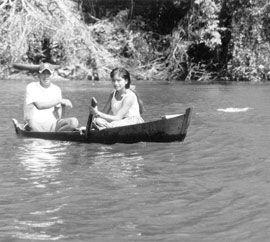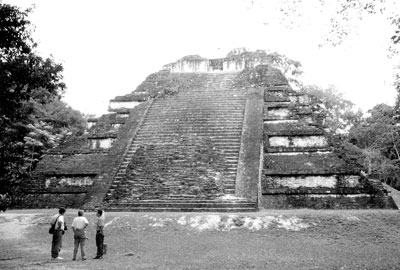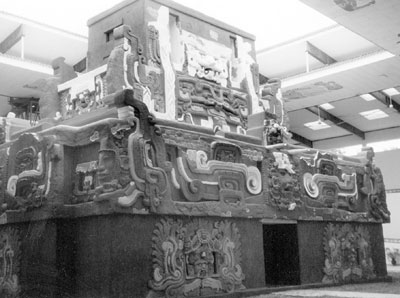Central America with Advantage Travel & Tours
Cathy Parda of Advantage Travel & Tours (Box 503228, San Diego, CA 92150-3228; phone 800/882-2098 or e-mail advantaget@aol.com) arranged our “refuge from the winter cold” trip to Central America. We had previously visited many of the Aztec and Mayan sites in southern Mexico and the Yucatan, but we needed to see Copan and Tikal and bask in the pleasant winter climate of Guatemala and Belize.
Our 18-day trip in January ’03 cost $2,978 per person, including air from Washington, D.C.
Chichicastenango, Guatemala, famous for its Sunday market, was our first destination. The market attracts vendors from the surrounding areas to sell their crafts and handiwork; it is colorful with members of each indigenous group wearing their traditional clothing. Among interesting items for sale were small limestone rocks used in the preparation of maize (they’re added to the boiling pot of kernels to prevent pellagra).
The town’s 400-year-old church, Iglesia de Santo Tomás, not only serves the Catholic community but is a place where the Quiché Mayan burn incense and perform rites to the ancient gods.
The Guatemalan highlands are dubbed “the land of eternal spring” for their warm days and beautiful cool evenings. We visited the highland village of Panajachel, on the shores of Atitlan, a beautiful crater lake ringed by colorful Mayan villages, before crossing the border into Honduras to tour Copán.
Copán is in a deep valley, first inhabited 2,000 years ago, and has probably the most magnificently detailed carvings of any of the Mayan ruins. The Museum of Mayan Sculpture has a full-size painted replica of the Rosalila Temple (A.D. 571); the original was found beneath pyramid Structure 16 of the complex. During Copán’s Golden Age (A.D. 553-600) it became a military powerhouse under King 18 Rabbit, who is called “King of the Arts” for all of the magnificent structures built during his reign.
Back in Guatemala we stopped at Quiriguá, in the lowland rainforest. The Grand Plaza contains the tallest Mayan stelae in Central America — 36 feet and weighing 65 tons!
We went by boat to Lívingston, on the mouth of the Rio Dulcé, unique for its Garifuna, or “black Mayan,” culture, a mixture of Caribe Indians and slaves from Nigeria who have retained their own language, music and religion.
We took a scenic 3-hour drive through El Petén jungle to reach the ruins of Tikal. With its five massive temples rising above the dense tropical jungle, it is the most popular site in Guatemala. The earliest buildings date from 500 B.C. and include the Temple of the Jaguar and the Temple of the Masks. By A.D. 1000 the city was deserted; the jungle hid it until it was rediscovered in 1881.
The country of Belize is noted for its coastal cayes, national parks and Mayan ruins, the most notable site being Caracol, probably the best-restored ruins visited on our trip, though we traveled a long and difficult roadway through the jungle to reach it.
We crossed the Mopan River on a hand-cranked cable ferry to reach the ruins of Xunantunich, and a boat took us to historical Lamanai with its magnificent temples and great views.
At Altun Ha, which contains the Temple of Masonry Altars, we met Belize’s Prime Minister, Said Musa, and his Foreign Minister, who were dedicating the site’s most recent restoration. Belize is making a major effort toward the restoration of many of her Mayan sites.
Our last three days were spent in Panama. Panama City shows influences of the Spanish, French and Americans. A visit to the Miraflores Locks was interesting as we had seen them on a previous transit of the canal. We also flew to one of the San Blas Islands.
LOWELL McDYSAN
Annandale, VA



